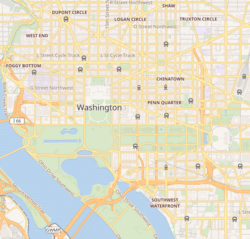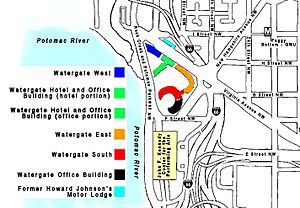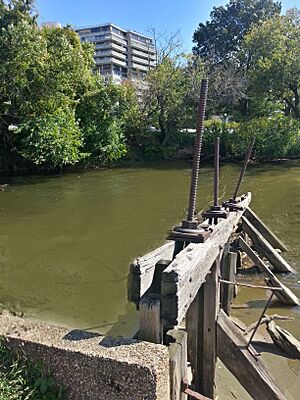Watergate complex facts for kids
Quick facts for kids |
|
|
Watergate
|
|
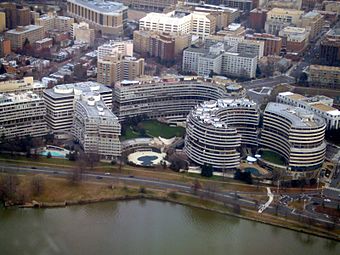 |
|
| Location | Washington, D.C. |
|---|---|
| Area | Foggy Bottom |
| Built | 1962–1971 |
| Architect | Luigi Moretti, consulting architect; Milton Fischer, associate architect; Boris Timchenko, landscape architect |
| Architectural style | Modern Monument |
| NRHP reference No. | 05000540 |
| Added to NRHP | October 12, 2005 |
The Watergate complex is a group of six buildings located in Washington, D.C., in a neighborhood called Foggy Bottom. It covers about 10 acres (4 hectares) and is right next to the John F. Kennedy Center for the Performing Arts.
The buildings in the complex include:
- Watergate West, with cooperative apartments.
- Watergate 600, an office building.
- Watergate Hotel.
- Watergate East, with cooperative apartments.
- Watergate South, with cooperative apartments.
- Watergate Office Building, where the famous Watergate break-in happened.
Built between 1963 and 1971, the Watergate was once a very popular place to live. Many members of Congress and government officials chose to live there. The complex has been sold many times since the 1980s. In the 1990s, it was divided, and different parts were sold to various owners.
In 1972, the main office of the Democratic National Committee (DNC) was on the sixth floor of the Watergate Office Building. Someone broke into their office, took pictures of private papers, and listened in on phone calls. An investigation by the U.S. Senate found that high-ranking officials working for President Richard Nixon had ordered this break-in. They also tried to hide their involvement.
This event became known as the Watergate scandal, named after the complex. It led to President Nixon resigning from office on August 9, 1974. Since then, the name "Watergate" and the ending "-gate" have been used by journalists to describe other big controversies and scandals around the world.
Contents
Exploring the Watergate Location
The Watergate area is surrounded by several streets. Virginia Avenue is to the north, New Hampshire Avenue to the east, and F Street to the south. To the west is the Rock Creek and Potomac Parkway, which runs along the Potomac River.
It is part of the Foggy Bottom neighborhood. The complex is right next to the Kennedy Center and the embassy of Saudi Arabia. The closest train station, Foggy Bottom-GWU, is about 0.4 miles (650 meters) away.
Watergate's Land History
For over 100 years, the land where the Watergate complex now stands was home to the Gas Works of the Washington Gas Light Company. This company made gas for heating, cooking, and lighting in the city. Gas production stopped there in 1947, and the plant was taken down soon after.
In the 1950s, the World Bank thought about building its main headquarters here. However, they decided not to and built their offices elsewhere in Washington, D.C.
Understanding the Name "Watergate"
The name "Watergate" has several interesting connections to the area's past and its location. As mentioned earlier, the name "Watergate" and the ending "-gate" are now used to describe many scandals.
The complex is located near the end of the Chesapeake & Ohio Canal. This canal was used from 1831 to 1924 and is now a National Historical Park. Parts of an old dam and a water gate from the canal are still visible nearby. The land for the Watergate complex was bought in 1960 by a company from Rome, Italy, called Società Generale Immobiliare (SGI).
There are a few stories about how the name "Watergate" came to be. One idea is that a publicist named Warren Adler came up with it. Another story suggests that a financier named Nicolas Salgo got the name from the "Water Gate Inn," a restaurant that used to be there. A third idea is that three local executives, including Giuseppe Cecchi, were inspired by the "Water Gate Inn" and suggested the name.
In 2009, William Noble wrote that the Watergate got its name because it overlooked a "gate" that controlled water flow from the Potomac River into the Tidal Basin. This gate is about 1.5 miles (2.4 km) downstream from the complex.
Before the complex was built, a restaurant called the "Water Gate Inn" operated on the site from 1942 to 1966.
In 2004, a writer for The Washington Post, John Kelly, suggested the name was most directly linked to the "Water Steps" or "Water Gate." These were ceremonial stairs west of the Lincoln Memorial that led down to the Potomac River. They were meant to be a grand entrance to the city. From 1935, a floating stage was anchored there for outdoor concerts. Up to 12,000 people would sit on the steps to listen to music. These concerts stopped in 1965 because of noise from jet planes at National Airport.
Building the Watergate Complex
Planning the Complex
The Watergate complex was built by the Italian company SGI. They bought the 10 acres (40,000 square meters) of land in February 1960 for $10 million. The plans for the project were announced in October 1960. Luigi Moretti was the main architect, and Milton Fischer was the associate architect.
The apartments were designed with special features like two-story units and top-floor units with private rooftop terraces and fireplaces. The complex was planned to have a very advanced security system. The grounds were designed by Boris V. Timchenko, a famous landscape architect. They included many plants, fountains that sounded like waterfalls, and swimming pools.
The Watergate complex was the first "mixed-use development" in Washington, D.C. This means it combined homes, offices, and shops in one place. It was meant to be like a "city within a city," offering many services so residents wouldn't need to leave. These services included a 24-hour receptionist, room service from the hotel, a health club, restaurants, a shopping mall, and medical offices. It was also the largest private building project in D.C. at that time.
Initially, the project was expected to cost $75 million. It would have six 16-story buildings with 1,400 apartments, a 350-room hotel, office space, shops, 19 luxury townhouses, and underground parking for 1,250 cars. The curved shape of the Watergate buildings was inspired by the planned Inner Loop Expressway and the original curved design of the nearby Kennedy Center. The curved shape also gave apartment residents great views of the Potomac River. Because of these curves, computers were used a lot in the design of the Watergate, making it one of the first major projects in the U.S. to do so.
Construction Progress
Building the Watergate complex took several years. The first building, the 110-foot (34 m) Watergate East, had its foundation and basement finished by September 1964. The main structure was built in October. In September 1964, the developers made a deal for the Washington Gas Light Co. to provide all the heating and air conditioning for the complex.
Watergate East was finished in May 1965. The first model apartment was shown to the public a month later. The building officially opened on October 23, 1965, and the first residents moved in a few days later. Apartments ranged from $17,000 for small units to over $250,000 for penthouses. By April 1967, almost all units were sold. The average apartment cost $60,000 and had two bedrooms. Each parking spot cost $3,000. In November, many stores opened on the ground floor, including a supermarket, pharmacy, beauty salon, bank, and restaurants.
Construction on the second building, an 11-story office building and hotel, started in February 1965. Both opened on March 30, 1967. The Watergate Hotel had 213 rooms, and the office building had 200,000 square feet (18,580 square meters) of office space. This combined building also had a health club and shops. In April, the Democratic National Committee rented office space there.
The third building, Watergate South, opened in June 1968. It had 260 apartments, more than any other building in the complex.
Work on the fourth building, the Watergate West apartments, began in July 1967. Apartments in this building, even before it was finished, started selling in October 1967, showing how popular the complex was. The Watergate West was completed in 1969. By then, the total cost of the project had reached $70 million.
Building the Fifth Structure
There was some disagreement about building the Watergate Office Building, which was the fifth and final structure. Its original plan was for a 140-foot (43 m) tall building. However, in June 1965, as work began on the nearby Kennedy Center, people involved with the Kennedy Center wanted the Watergate building to be shorter. They felt a taller building would block the view and spoil the look of the Kennedy Center. The Watergate developers said their building would stay at the agreed-upon height.
This disagreement lasted for almost two years, delaying construction. Residents of the Watergate apartments, like Senator Wayne Morse, also tried to get officials to make SGI agree to the Kennedy Center's wishes. Even though SGI seemed to be winning the legal arguments, city planners tried to find a compromise.
In April 1968, SGI agreed to slightly turn its fifth building. This would open up the Watergate complex more and give the Kennedy Center a bit of open space. The Kennedy Center accepted this, but also asked that the fifth building include apartments, not just offices, to keep the area residential. After more discussions and hearings, SGI and the Kennedy Center agreed in August 1968 that only 25 percent of the building would be office space, with the rest being apartments. This revised plan was approved later that year.
The fifth building was finished in January 1971. Its first major tenant was the Manpower Evaluation and Development Institute. In October 1972, several fancy shops and a restaurant opened in a retail area called "Les Champs." The total cost for the entire Watergate project was $78 million.
Watergate Buildings Today
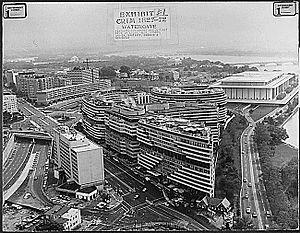
The entire Watergate complex was first owned by Watergate Improvements, Inc. In 1969, the Vatican sold its share in SGI, so it was no longer a part-owner of the Watergate. Even though the Watergate was seen as a very fancy place to live, residents and businesses started complaining about building problems, like leaky roofs, as early as 1970.
The three Watergate Apartment buildings have about 600 homes in total. Many famous people have lived there, including Bob and Elizabeth Dole, Plácido Domingo, Ruth Bader Ginsburg, Alan Greenspan, Monica Lewinsky, Robert McNamara, Condoleezza Rice, and Elizabeth Taylor. Because so many officials from the Nixon administration lived there, the press nicknamed it the "Republican Bastille." In the 1980s, it became known as the "White House West" because many officials from the Reagan administration lived there.
The Watergate complex changed owners in the 1970s. Each building was sold separately in the 1990s and 2000s. Strict rules make sure the apartment buildings remain homes. For example, in Watergate South, owners cannot rent their unit for the first year, and no lease can last more than two years. In 2005, all the retail space in the complex was put up for sale.
Not much new building has happened at the Watergate in the last 40 years. The complex still has three luxury apartment buildings, the hotel/office building, and two office buildings. The entire development was added to the National Register of Historic Places on October 21, 2005.
Watergate East Apartments
The Watergate East apartment building is very well-known. It became one of the most desired places to live in the city when it opened in 1966.
However, problems with the building started soon after people moved in. The roof was leaking by 1968. In 1970, the press even called the building the "Potomac Titanic" because of its issues. Residents filed lawsuits against the developer to fix the problems.
Watergate East was also the site of a large protest in 1970. Political activists planned a protest at the home of United States Attorney General John N. Mitchell, who lived in Watergate East. On February 19, several hundred protesters gathered outside the building and tried to get in. Police stopped them, and there was some street fighting. Police used tear gas to break up the crowd, and over 145 protesters were arrested.
Watergate Hotel and Office Building
The Watergate Hotel and Office Building is another important part of the Watergate development.
The Watergate Hotel
The hotel's management and ownership have changed many times since the mid-1980s. In 1986, Cunard Line, a cruise ship company, took over managing the hotel. Various companies bought and sold the hotel over the years.
The hotel closed on August 1, 2007, for a big renovation. However, the renovation never happened, and the building stayed empty for years, costing a lot of money for security and utilities. Due to financial problems, the hotel was put up for sale multiple times and changed hands.
Euro Capital Properties bought the hotel in May 2010 for $45 million. They planned to fix it up over the next two years. In January 2013, Euro Capital announced an $85 million renovation. They planned to add outdoor "summer gardens" and increase the number of luxury hotel rooms. They also wanted to renovate the lobby, add a bar, a restaurant, and a rooftop bar.
In May 2014, Euro Capital received permits for its now $100 million renovation. The renovation included replacing old systems like electrical and plumbing. It also featured two new restaurants, upgraded ballrooms, and a new spa and fitness area. The meeting space was expanded, and the ballroom was made a bit larger. The new rooftop bar was designed to seat 350 people. The exterior's famous concrete balconies were kept, but repaired and repainted. The 336-room hotel finally reopened in 2016, nine years after it closed.
Office Building
The office part of the building has 198,000 square feet (18,394 square meters) of space.
In 1972, the headquarters of the Democratic National Committee (DNC) was on the sixth floor of this building. On May 28, 1972, a group of people working for President Richard M. Nixon's re-election campaign secretly listened to phones and took photos in the DNC chairman's office. They monitored these activities from rooms across the street at the Howard Johnson's Motor Lodge. During a second break-in on June 17, 1972, five of these people were arrested. This event started the Watergate scandal. A special marker on the sixth floor of the office building remembers this break-in.
The DNC break-in was not the first at the Watergate. In 1969, Rose Mary Woods, President Nixon's personal secretary, had her apartment in the complex broken into. Jewelry and personal items were taken. Woods was later accused of deleting 18 and a half minutes from President Nixon's secret Oval Office audio tapes. This tape, from June 20, 1972, was very important to the Watergate scandal.
The office building has also changed owners several times. In 1993, a British pension fund sold the office part of the building to American and Dutch companies. Later, it was sold to the Blackstone Group's Trizec Properties. In 2005, Trizec sold it to BentleyForbes Acquisitions. In 2011, after being on the market for 20 months, the office building was sold for $76 million to the Penzance Cos.
In 2012, the new owner began a multi-million dollar upgrade to the lobby and common areas of the Watergate Office Building. The renovations were finished in December 2012, and the building started renting space again in January 2013. In 2016, Penzance sold the office building to Rockwood Capital for $75 million. Penzance still manages the building.
Watergate South Apartments
One notable person who has lived at Watergate South is former Secretary of State Condoleezza Rice. Residents of this building have thought about buying the land beneath their building, but they don't need to do so urgently because their land lease doesn't end until 2070.
Watergate West Apartments
Like other buildings in the complex, Watergate West had construction problems and leaks, leading the press to call it the "Potomac Titanic." In March 1971, residents of Watergate West sued SGI. They claimed their apartments had broken stoves, bad air conditioning, leaky windows, and faulty plumbing. SGI said these were normal problems for a new building and that they had already spent $300,000 on repairs.
Similar to Watergate East, residents of Watergate West have discussed buying the land under their building. However, they also don't need to do this until their land lease expires in 2070.
Watergate 600 Office Building
Britain's National Coal Board Pension Fund sold the Watergate Office Building (also known as Watergate 600) to John Hancock Mutual Life Insurance in the early 1990s. The building's offices were renovated in 1994 and again in 1997.
The Atlantic magazine owner David G. Bradley bought the office building in 2003. He renovated it again, making the lobby and restaurant space larger.
In March 2017, the Washington Real Estate Investment Trust (WashREIT) bought the building from Bradley for $135 million. The new owner plans to continue renovating parts of the building, improve the rooftop areas, and add a new fitness center and conference center.


